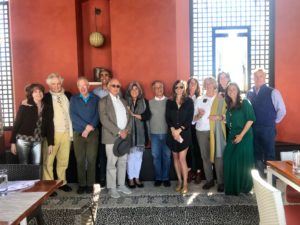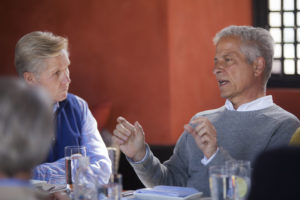“I am a lover of classical music, not a musician. I hope to bring music to the ears of all society as I believe it brings happiness and cultural richness to our lives.” Alys Stephens
In 2007, grass roots activist, and Scenic Corridor Advocacy Chair and Consultant to Walton County for Scenic Highway 30A, Claire Bannerman was instrumental in securing the scenic highway designation for 30-A. “By forming an alliance, the new urbanist towns will have the opportunity to realize their original vision that began with Robert Davis thirty-six years ago,” she says.
Eleven years later, on Friday, March 9, 2018, as the disquiet caused by spring-break season mounted among locals, twelve titans of the new urbanism inched along slowly in the stream of traffic on Scenic Highway to reach their destination – Caliza Pool at Alys Beach. There, the founders, vice presidents, and managers of the three new urbanist towns situated along 30-A – Seaside, Rosemary Beach, Alys Beach, (and Hampstead to the north), would sit together for the first time since the alliance’s inception, and share a meal.
The gathering was reminiscent of the first meals cooked in Seaside in the early 1980s, where a young architect named Ernesto Buch served Cuban comfort food for the original team of architects and designers – when Seaside was still just the brushstroke of a handful of small houses. (Seaside founder, Robert Davis, nicknamed his the “Night Crew” this group after their late-night bohemian work habits.)
Now, thirty-six years later, the current leaders have assembled inside the Salon Marocain Loggia at Caliza Pool. Robert Davis raises a glass to toast Alys Stephens for her contribution to the arts, which sets a tone of remembrance for the historical underpinnings of the area.
“Here’s to Alys Stephens, whose spirit lives on in this beautiful place and in this gathering to discuss both music and community. Alys was a strong supporter of classical music in Birmingham and Seaside. She arranged for Sam Howard and and Dolores Hodges; dual pianists extraordinaire; to come to Seaside. Their recitals for piano – four hands at sunset overlooking the Gulf – stand out as magical memories from Seasides early years. She introduced us to Paul Polivinick, Conductor of the Alabama Symphony; whose performance of Beethoven’s Eroica Symphony in the new Seaside Amphitheater was mesmerizing. A storm threatened, but the heavens waited until just after the final notes. And then the deluge created its own climax to the evening.”
Coordinated by Alyssa Walker, Marketing Director for Alys Beach, the luncheon was hailed as our region’s inaugural New Urbanist Summit and the brainchild of Andrew Balio. Appointed as Principal Trumpet of the Baltimore Symphony Orchestra, Balio and his wife recently launched The Future Symphony Institute, a think-tank to examine the complexities of making symphony orchestras financially viable while preserving their artistic mission. To this end, Balio hosted a symposium called Building Communities with Music from March 9th -11th at The Seaside Institute.
Balio explains, “The Future Symphony Institute is seeking to orchestrate a Renaissance for classical music; and architecture and urban design will have to figure prominently in that process if we are to renew our role in society. We selected Seaside, Rosemary, and Alys to show that there is a significant movement towards a renewal of various classical architectural styles.”
The honorary dignitary at the table was Léon Krier, a founding member of the new urbanist movement and senior fellow at the Future Symphony Institute. As an architectural theorist and urbanist, Krier is an advocate for the role that architecture and urban planning play in human settlement, and how they shape and are shaped by healthy communities. Krier plans for Poundbury in Dorset, England on behalf of HRH Prince Charles, and his influence on Andres Duany – Town Planner for Seaside, Rosemary, Alys Beach, and Hampstead – have been a major influence on the New Urbanism and the renewal of classical style.
Anna Lowder; founder of Hampstead, the new urbanist town in Montgomery, Alabama; referred to Krier, Davis, and Duany as titans in a social media post. “Really, I was just deliberating on how fundamentally important these 30-A communities have been to the New Urbanism movement over the past 30 years. They are the best representation and implementation of New Urbanism principles, and their success from a development and tourism perspective is the evidence of this. We all stand on the shoulders of these minds and their communities.”
The three titans were surrounded at the table by Dhiru Thadani (Architect and Urbanist), David Bailey (Town Manager for Rosemary Beach), David Everett (Vice President for Alys Beach), Tom Dodson (Vice President of Sales for Alys Beach), Rick Helfand (Chair of The Seaside Neighborhood School Foundation), Claire Bannerman (Host of “Our Coastal Art Scene” for Seaside Radio), Joyce Wilson (Artistic Director for the Ogden Museum at Watercolor and Arts & Culture Activist) and Anna Lowder and Harvi Savota (Founders of Hampstead).
“We believe the key architects, familiar to the people of 30-A, hold a great deal of wisdom for helping not only orchestras but all arts to be relevant to their communities. The Seaside Institute is a nexus for bringing together people who have their hearts and minds in-sync when it comes to architecture and urban planning that puts people first,” said Balio.


Balio enlisted renowned documentarian David Donnelly, director of the hit film Maestro, to capture the magic that occurred during this meeting of minds. For a period of two years, his film crew followed Grammy award-winning conductor Paavo Jarvi and an array of brilliant musicians. “I’ve been working with Andrew Balio and the Future Symphony Institute for over a year. I have been inspired by Andy’s passion to apply the beauty of classical music to other areas of life,” says Donnelly.
Duany proposed that the four 30-A communities – Seaside, WaterColor, Rosemary, and Alys Beach form an alliance to protect their culture and to enhance the sophistication of each town, as well as ensuring the protection of the State Parks and State Forests and its 22,000 acres of preserve.
Anne Hunter is a gallerist and freelance writer on arts and culture. She serves on the board for The Seaside Institute. Read an excerpt of the story in the May/June issue of Thirty-A Review.








